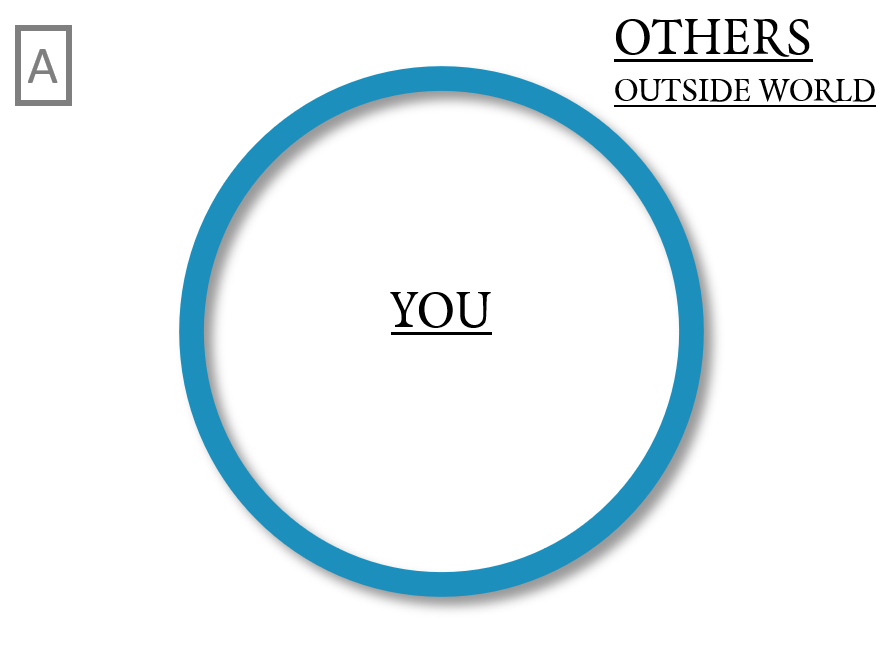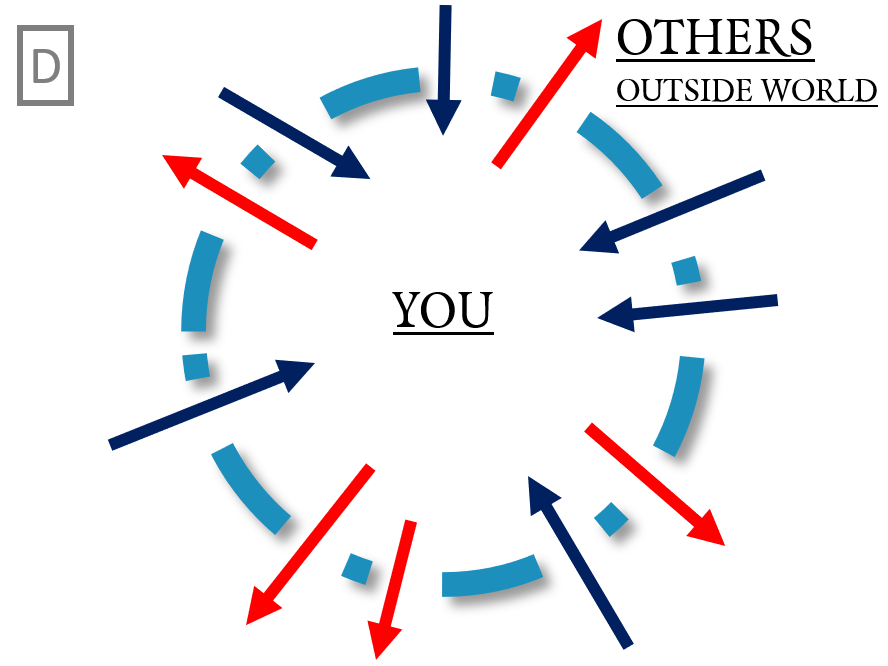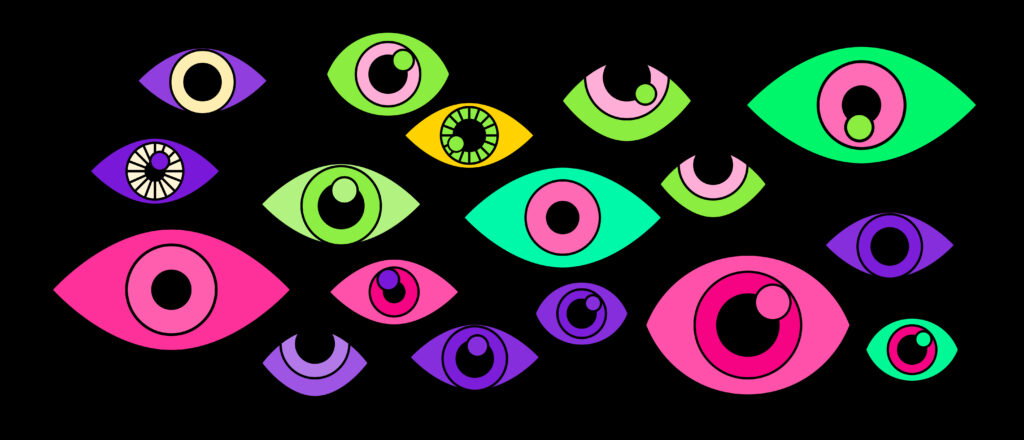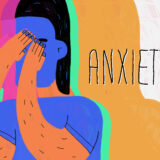The boundary between yourself and others

Self-disturbance literally means that the state that you are disturbed inside yourself. To depict this more simply, think of yourself as “YOU” and “OTHERS” or outside world as shown in Figure A.

What you think about yourself is certainly within this circle, and other people and the surrounding environment as the outside of the circle.
Mental activity includes input and output

As shown in Figure B, healthy mental activity means that you control the two directions of the inward and outward arrows with your own will on a daily basis. The inward arrow is your input, and the outward arrow is your output.
The mental activity you are doing right now, reading this article, taking in the information and trying to understand the content, is certainly input. It also refers to all other input activities through the five senses, such as listening to others, seeing a beautiful scenery, smelling the plants and trees, and so on.
On the other hand, output refers to activities such as composing thoughts and speaking, working on tasks, and trying to interact with others and the environment.
In order for input and output to occur smoothly, it is necessary to take in information appropriately, process it appropriately within oneself, and express it appropriately through words and actions.
Everything we do, from the things we do without efforts to the things we do with labor, is accompanied by these activities in these two directions. It is only when these activities take place that we are able to carry out our life and social activities.

On the other hand, there are times when we choose NOT to do input or output.
For example, when you are meeting someone in a crowded place, you are probably looking for that person, trying NOT to pay attention to the many other people and the hustle and bustle of the city so that you can find only that person.
Likewise, if you hear a motorcycle outside your window or people chatting in the hallway while you’re in class, as long as you don’t pay attention to them (and as long as the class is interesting (!), you’ll be able to focus on the class.
Also, the sound of the air conditioner in the office can certainly be heard if you pay attention to it, but it usually doesn’t bother you at all and you wouldn’t mind it.
These things are possible because although there is an inward arrow coming toward you, you selectively reject the stimulus as shown by the folded arrow in Figure B.
Some of the selective stimuli are conscious, such as when you are meeting someone, and some are unconscious, such as the air conditioning in your office like the examples above. Both are the same in that you are the one who is doing them.
The same is true for your output.
The content of your speech does not come out of your mouth, but you make many decisions, both consciously and unconsciously, depending on the purpose of the conversation and the person you are speaking to, such as choosing the right words or using more polite way.
This ability to selectively input and output in a controlled manner is actually due to the boundaries between you and others.
Now, in order to understand this further, I would like you to imagine what input and output would look like if the boundary were injured.
Note that the boundary between you and others is called the self-boundary.
Self-disturbance: the boundary is lost

Now, look at Figure C.
The outline of the circle has become a dotted one.
What happens in this kind of self-boundary? You will notice that ALL of the arrows for input and output will come in and go out without being filtered. This is self-disturbance.
When you are in such a situation, all the stimuli from the outside come into you, and you are unable to block out even the slightest noise or slightest movement, and they come into you.
The fact that they enter your mind means that they are perceived as information that you need. Therefore, all stimuli are perceived as being about you. If your self-boundary was solid, you would have been able to consciously or unconsciously reject stimuli that were not necessary or relevant to you, but this time, your brain will have to process them ALL as your own affairs.
Just being there, regardless of what you see or hear, and having all the stimuli come to you, whether you want them or not, is an extraordinary situation.
I can hardly imagine how this frightening experience can cause a great deal of anxiety and a sense of crisis in a person.
In addition to this, the brain is forced to work very intensively because all the stimuli are inputted and processed.
Because of this overwork of the brain, you may be feeling tired easily, lost energy, feel anxious, become depressed because you cannot maintain your mood enough to go out and socialize.
As an extension of this, suicidal thoughts may arise.
The stimuli start to relate everything around you

As the self-disturbance becomes more pronounced, for example, stimuli that were only perceived as noise or ringing in the ears eventually become “auditory hallucinations” with meaning. This leads to the formation of delusions.
There are two hypotheses for this;
The first is that humans have nature of trying to find explanations for inexplicable phenomena in order to be convinced yourself. The process of relating everything around you would transform meaningless stimuli into meaningful ones, which further confirm the doubts to delusions.
Another theory is that the processing of stimuli in the brain becomes overheated because all the stimuli enter the mind (=brain), causing an excess of some substance (= particularly dopamine) that forms hallucinations.
Both of these theories are not beyond the realm of hypothesis, but it seems certain that the former plays a role in the formation of delusions, while the latter plays a role in the formation of hallucinations.

Also, since we cannot control our output either under the self-disturbance, we start to think that what is inside of us goes out on its own.
In patients’ words;
“my thoughts are being taken away or gouged out.”
“my information is being revealed to others.”
and as it progresses further;
“my information is being leaked to the whole world on Facebook.”
“I am being tapped and monitored.”
These hallucinations and delusions will eventually come to control the person, and the master-slave relationship will be reversed.
As explained in the future article on psychotic symptoms, the breakdown of output leads to loosening of association to incoherence, and the breakdown of input leads to ideation to delusion.

As you can imagine, when the situation becomes this urgent, you would be hardly able to sleep.
Because if you fall asleep, you couldn’t help but think that something terrible would happen in the meantime, and even the dotted line of the self-boundary will disappear, and you will lose your “self”.
At this point, your physiological “emergency alarm” will continue to go off 24 hours a day, and you will not be able to rest nor relax. Many people begin to experience shallow sleep or insomnia.
When the hallucinations and delusions reach their peak, and you would feel that you cannot secure your own safety on your own, you may not be able to sleep for several days or more. It is just like a soldier in war. Or perhaps it may be even more extreme than that.
>To understand self-disturbance more deeply: To be continued.




